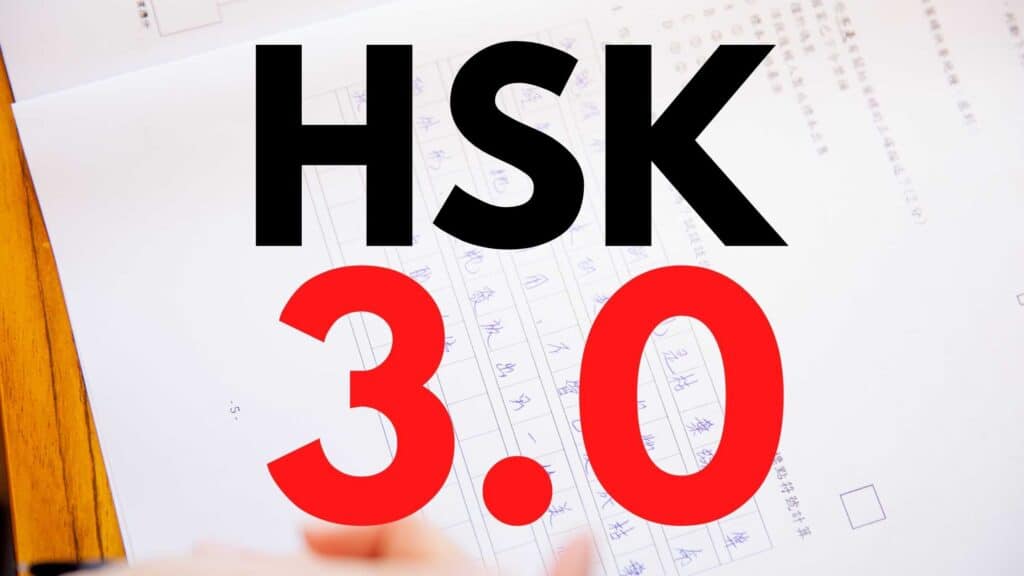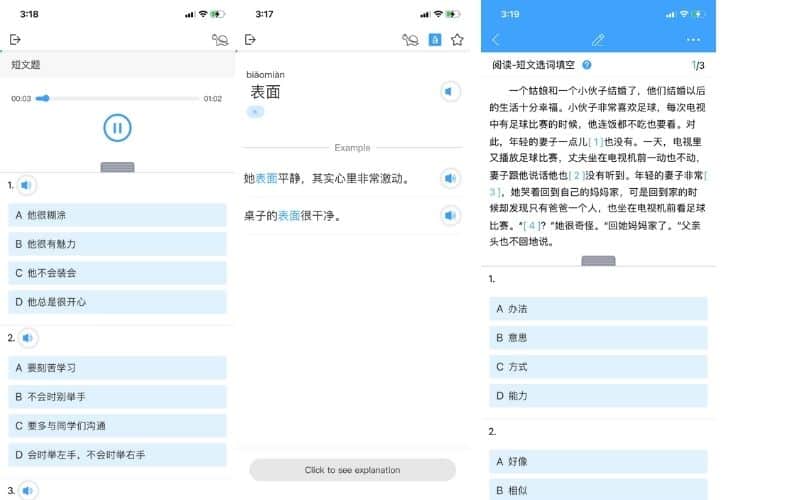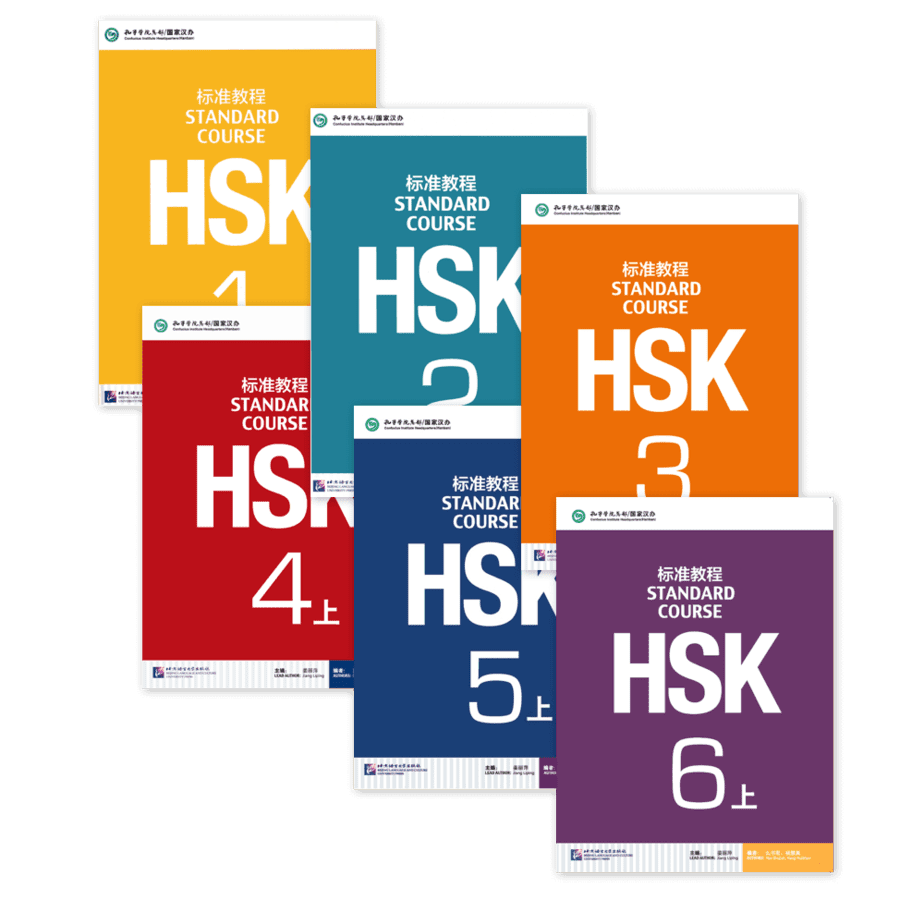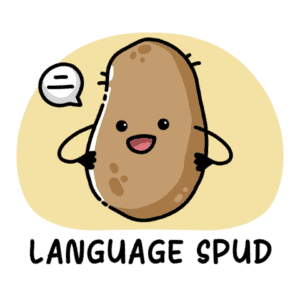
If you’ve been learning Mandarin for any amount of time, you’ll likely have heard of The HSK. But what’s the deal with the HSK and why is every learner of Mandarin seemingly so obsessed with it?
Well, this super-mega-whopping guide shall reveal all about the HSK and answer any questions you might have.
If you’re looking for an answer to a specific question regarding the HSK, make use of the hyperlinks below.
- What is the HSK?
- Why do I need a HSK certificate?
- Why is the HSK being updated?
- What’s new for HSK 3.0?
- Is the new HSK more difficult?
- When will the HSK exams change?
- When and where can I get HSK 3.0 study materials?
- Is my current HSK certificate still valid?
- How long does it take to pass each level of the HSK?
- How much faster can I learn?
- HSK study resource list
- Do I have to study for the HSK if I don’t want to take the test?
- How useful are the HSK textbooks for learning Mandarin?
What is the HSK?
The HSK – 汉语水平考试 (Hànyǔ Shuǐpíng Kǎoshì) is the international standardised proficiency test for learners of Mandarin Chinese and is predominantly used in China. You can take the HSK in many other countries around the world.
In Taiwan, The TOCFL (Test of Chinese as a Foreign Language) is used instead of the HSK.
The HSK currently only tests reading, writing, and listening skills.
A separate test, the HSKK, is available to those who aim to test their speaking proficiency.
There are 6 levels of the HSK currently, although this is set to change.
Why Do I Need a HSK Certificate?
The main uses of a HSK certificate are as follows:
- To acquire a job that requires Mandarin skills – in many cases in which an employer requires you to showcase your Mandarin skills, they’ll first ask for a HSK certificate as evidence.
- To enter a Chinese University – If you’re planning to complete a degree course in China that is led in Mandarin, most courses will ask for a HSK 5 certificate at the minimum.
- To obtain a scholarship for a Chinese university – Chinese universities give away a lot of scholarships. Usually, the higher your level of Mandarin, the higher your chances of getting the scholarship you’re applying for. The university in question will ask for your HSK test results.
- To gauge your study progress – A lot of Mandarin learners decide to align their studies with the HSK despite having no intentions of taking a HSK exam. Is this a good idea? That’s debatable…
The HSK does serve as a somewhat acceptable benchmark to gauge your progress in Mandarin Chinese, but it does not necessarily reflect your overall ability in the language.
I’ve met students of Mandarin Chinese who have passed HSK 6 who can barely string a sentence together, and I’ve met student with a HSK 4 who can converse very comfortably with locals in China.
Why is the HSK being updated?
Back in the old days (pre 2010), The HSK consisted of 11 levels.
Rumour has it that this version of the test was much more challenging than the current version. The advanced stages of the old test included a plethora of obscure cultural references, vocabulary, and grammar.
In 2010, the powers that be wanted to make Mandarin Chinese more accessible to the wider world, so they made the HSK easier.
However, now they have the opposite problem to what they had before. Many argue that the current test is too easy, and those who pass the HSK 6 are only at an upper intermediate level at best. Hence the need for a HSK 3.0.
What’s New for HSK 3.0?
The HSK 3.0 will be different in a number of ways, so let’s take a look at the different areas of the exam where you’ll see the most significant changes.
Vocabulary and Grammar
Firstly, let’s look at the differences in terms of the number of vocabulary and grammar points.
You’ll also notice in the table below that an extra 3 advanced levels have been added to the new HSK (levels 7, 8, and 9).
| HSK 2.0 | ||
| LEVELS | WORDS | LANGUAGE POINTS |
| HSK 1 | 150 | 44 |
| HSK 2 | 300 | 92 |
| HSK 3 | 600 | 143 |
| HSK 4 | 1200 | 205 |
| HSK 5 | 2500 | 237 |
| HSK 6 | 5000 (but you’ll need to know much more passive vocab than this) | 260 |
| HSK 3.0 | ||
| LEVELS | WORDS | LANGUAGE POINTS |
| HSK 1 | 500 | 48 |
| HSK 2 | 1272 | 129 |
| HSK 3 | 2245 | 210 |
| HSK 4 | 3245 | 286 |
| HSK 5 | 4316 | 357 |
| HSK 6 | 5456 | 424 |
| HSK 7-9 | 11092 | 572 |
As of March 2022, the new HSK 7-9 exam has been launched. The HSK 7-9 test will be the same test paper (there won’t be a separate exam/paper for HSK 7, 8, and 9).
Here is a complete wordlist for the new HSK. However, be aware that this list doesn’t include a breakdown for HSK 7 and onwards.
Handwriting
With the HSK 2.0, you’re able to choose whether to do a handwritten test or a computer based test.
With the HSK 3.0, they have introduced a compulsory handwriting element for everyone doing the test at every level.
In the new HSK exams, from levels 1-3, you will have to be able to copy a certain amount of characters. There’s also a minimum amount of set time you’ll be given to copy those characters.

You can find the HSK 3.0 handwriting character list for all levels here.
Translation
Although the details haven’t been made clear at this point, those studying for the HSK bands 4 and above must complete translation activities.
We can assume that the translation part of the exam will be rather basic for the HSK 4, and those taking the higher level exams will approaching a pro-level ability in translation.
Overseas HSK and HSKK changes
From 2022 onwards, all overseas students taking the HSK 3 to HSK 6 test exams are required to take both the HSK and HSK Oral Test (The HSKK).
This currently only applies to overseas students, not to those taking the HSK in China.
The written and spoken part will be combined in the same testing package. You won’t have to arrange the tests separately.
So, if you’re an overseas student taking a HSK exam at band 3 or above, you’ll have to take the corresponding oral test displayed below.
HSK 3 + 初级 | Primary oral test
HSK 4 + 中级 | Intermediate oral test
HSK 5 + 高级 | Advanced oral test
HSK 6 + 高级 | Advanced oral test
HSK Written and Speaking test result reports will be issued together.
The online HSK
The online home examination service is still available. You will now have to take HSK written test and oral test at the same time.
The home online examination service fee has also increased.
For more up to date information regarding the registration for the online HSK, you can check updates on the official website here.
For a very thorough and in-depth guide to taking the online HSK, the Confucius Institute of Berlin has provided one that you can find here.
Is the New HSK more difficult?
As you can see from the added sections of the new HSK exam, it’s safe to say they will be more difficult than the old ones. This is kind of the point of the update, though.
| HSK Level | Syllables 音节 | Characters 汉字 | Vocabulary 词汇 | Grammar Points 语法 | |
| Beginner | Level 1 Level 2 Level 3 | 269 468 (+199) 608 (+140) | 300 600 (+300) 900 (+300) | 500 1,272 (+772) 2,245 (+973) | 48 129 (+81) 210 (+81) |
| Intermediate | Level 4 Level 5 Level 6 | 724 (+116) 822 (+98) 908 (+86) | 1,200 (+300) 1,500 (+300) 1,800 (+300) | 3,245 (+1,000) 4,316 (+1,071) 5,456 (+1,140) | 286 (+76) 357 (+71) 424 (+67) |
| Advanced | Levels 7-9 | 1,110 (+202) | 3,000 (+1,200) | 11,092 (+5,636) | 572 (+148) |
However, there are reasons to be positive.
- Updated vocabulary – The HSK wordlists generally correspond to the most commonly used vocabulary in Mandarin. Languages evolve, and so do commonly used words. The updated vocabulary is much needed, as there are a few words in the HSK 2.0 that are rarely used these days – stuff like 丝带 (cassette) and 传真 (fax).
- A more accurate indicator of Mandarin ability – Although many consider a current HSK 6 test certificate to be an indication of advanced Mandarin ability, it really isn’t. Trust me. It’s certainly a great achievement, but passing the HSK 6 does not put you close to a C2 level on the CEFR framework (truly advanced). Whilst the introduction of the HSK 7-9 levels may seem daunting, it’s necessary to find the truly advanced learners of Mandarin.
- New study materials – Perhaps I need to get out more, but I like the smell and feel of shiny new books…
When will the HSK exams change?
As mentioned previously, as of March 2022 the exam for the HSK 7-9 has already been launched.
The exam for the new HSK levels 1-6 has not been launched, and there is no set date for it’s rollout. However, according to Chinaeducenter, we can expect the HSK tests for bands 1-6 to be altered gradually over the next 3-5 years.
When and where can I get HSK 3.0 study materials?
Despite the new exams for the HSK 7-9 having already been launched, there are still no official new study materials for the HSK 3.0.
The only HSK 3.0 study tools are the updated vocabulary lists which you can find here.
If you plan to take the HSK test in the next few years, there are absolutely loads of study materials already aligned with the HSK 2.0.
Be aware that many of the vocabulary and language points in the HSK 2.0 also feature in the updated version of the HSK.
If you’re looking for a large collection of HSK study materials, look at the last section of this post.
Is my current HSK certificate still valid?
Yes.
The scores and certificates of those taking the HSK in it’s current format are still valid.
This is likely to change once the new exams and study materials are rolled out.
However, as mentioned previously, the process for rolling out the updated HSK exams for levels 1-6 is likely to be a lengthy one.
How long does it take to pass each level of the HSK?
Currently, for each new HSK level, you’re doubling your knowledge of vocabulary from the previous level.
Taken from the official HSK website, the following are the guidelines on how long it will take to pass each level of the current HSK (HSK 2.0).
- HSK 1: 150 words – The HSK (Level I) can be completed by those who have studied Chinese for one semester, with 2-3 class hours each week. These students have mastered 150 commonly used words and basic grammar patterns.
- HSK 2: 300 words – The HSK (Level II) can be completed by those who have studied Chinese for two semesters (an academic year), with 2-3 class hours each week. These students have mastered 300 commonly used words and related grammar patterns.
- HSK 3: 600 words – The HSK (Level III) is intended for students who have mastered 600 commonly used words and related grammar patterns.
- HSK 4: 1,200 words – The HSK (Level IV) is for students who have studied Chinese 2-4 class hours per week for four semesters (two academic years). These students have mastered 1,200 commonly used words and related grammar patterns.
- HSK 5: 2,500 words – The HSK (Level V) is for students who have studied Chinese 2-4 class hours per week for more than two academic years. These students have mastered 2,500 commonly used words and related grammar patterns.
- HSK 6: 5,000+ words – The HSK (Level VI) is for wizards only, and you can get there in around 4 years of full-time study.
How much faster can I learn the HSK?
I shall now provide an answer you probably won’t like, but it’s the bare, naked truth, and it’s what you need to hear:
It depends.
There are a variety of factors that affect your speed of progress in studying for the HSK, and in Mandarin in general.
- Desire – This is the biggest one. If you want it enough, you’ll find a way. You’ll quickly realise that 90% of the details of how you learn don’t matter as much as your will to succeed and the time you spend with the language.
- Environment – Although it’s not essential given the developments in technology, living in a Mandarin-speaking environment certainly helps. I studied Mandarin at a University in China – an experience I have written about here. It was during this intensive study period (with a practical ban on English in the classroom) where I saw the biggest increase in my level of Chinese.
- Native Language – If you’re an English person who has never learned another language before, you’re probably going to find things more difficult than a Japanese polyglot who can already read and write a lot of Chinese characters before they’ve picked up a textbook or set foot in a classroom.
- Language Aptitude – Although it’s true that almost anyone can learn a second language, some are better at it than others. However, this can be overcome by having plenty of desire to learn.
- Access to Resources – There are thousands of resources available today that are aligned with the HSK. Many excellent resources are free, but some aren’t. Studying for the HSK isn’t an expensive endeavour, but there are one or two things I strongly recommend paying for.
Any perceived disadvantage you have when it comes to learning the HSK can be overcome by focussing on the first point on this list – desire.
If you want to learn Chinese badly enough, you’ll make it happen.
HSK Study Resources
There are loads of resources out there that can help you learn the HSK at a faster pace, including a good quality textbook.
If you’re studying Mandarin specifically to pass the HSK, then I recommend the following…
HSK Online App – SuperTest
An absolutely awesome app packed with loads of materials to learn the HSK content step-by-step. It is also filled with practice exam style questions and exam papers.

The SuperTest app is a paid app but it’s well worth the money. For a one-off purchase of less than 50 dollars, you have everything you ever need to pass every level of the HSK.
That works out cheaper than buying all of the HSK textbooks!
HSK Textbook

Probably the most commonly used textbook among Chinese learners, but not necessarily the best.
However, it’s perfect for you if your primary goal is to pass the HSK.
It’s not something you should solely rely on to become fluent in Mandarin, but it provides a very solid base to build on and it can be a good marker for your progress.
I have the audio from my HSK textbook on my phone, and I have all of the texts saved as documents in the Pleco app.
I have all of the HSK word lists on Anki, and I refer to the workbook and textbook regularly to progress.
All of the HSK textbooks and workbooks can be found on Amazon, and you can find the textbook and workbook HSK 1 set here.
Learning Characters
Flashcard apps with spaced repetition software are what you need to learn characters rapidly, and these apps are a dime a dozen these days.
Because the HSK is well-known among learners of Mandarin, the following apps have plenty of pre-made HSK study lists.
- Anki (free*) – Probably the most well-known flashcard app out there and used by millions of language users all over the world. HSK decks are available and cards are highly customisable, which takes some getting used to. Anki is almost too good. For iOS users, Anki charges a one-off $25 for the app. Still, this pays for itself 1000 times over if you make good use of it.
- Memrise (free) – Every HSK level word list is available on Memrise, and you can make your own as well. It’s slightly ‘gamier’ than Anki, which I quite like. Memrise is free with paid add-ons available, but I’ve never used them.
- HackChinese (paid) – Very new, but probably my favourite site for learning characters. There is no app available yet, but the site works just fine. Basically, the advantage HackChinese has over Memrise and Anki is that it won’t make you re-learn all of the words from a previous HSK list after you’ve started a new HSK list.
- Skritter (paid) – If you want to learn to write characters, Skritter is by far the best app on the market and worth every penny for its subscription. It’s a writing flashcard app, and no other writing app comes close. Make use of the free trial and see for yourself. All HSK levels are available as courses.
- Pleco (paid) – I consider Pleco an essential app for learners of Mandarin Chinese. Every foreigner I know in China has Pleco on their phone, primarily for its dictionary, but with the basic bundle ($29.99) you get loads of other stuff as well (OCR, handwriting, text file stroke order diagrams, audio pronunciation, etc). I have the basic bundle, and it has served me well for many years.
Reading
As well as the HSK textbook, there are two awesome graded reading apps that I recommend.
The Chairman’s Bao and Du Chinese contain literally thousands of Chinese news articles and short stories, all categorised by HSK level.
If you’re looking to do more extensive reading (as you should) you can find all of my favourite graded readers here.
Listening
The best resources for listening are past papers or audio from the textbook and workbook.
You can find other previous audio sections of HSK exams on YouTube.
I have also compiled a large list of useful YouTube Channels for learning Mandarin, many of which contain loads of HSK learning material. You can find that list here.
Check this out if you want free access my ultimate list of Mandarin learning resources.
Where can I find previous exam papers for the HSK?
When you purchase the HSK textbook, you have the option of buying the accompanying workbook.
This workbook contains many mock exams and other exam style questions from the HSK. It’s very useful, and I strongly recommend buying it if you intend to take the HSK any time soon.
- WWW.CHINESETEST.CN – Select your required HSK level in the left-hand panel, then access the sample test papers and audio. If you’re a complete beginner, check out the HSK 1 test here.
- Manchester University Confucius Institute
- China Education Center
- Dig Mandarin
Do I have to study for the HSK if I don’t want to take the test?
No.
If you study for the higher levels of the HSK using HSK study materials, you will learn a lot of Mandarin. However, there are many, many more exciting ways you can learn Mandarin Chinese.
If you want a whopping list of suggested study materials, you can check out out my Learning Mandarin Resource Collection page.
How useful are the HSK textbooks for learning Mandarin?
The HSK textbooks can be useful for learning Mandarin if utilised in the right way.
They definitely shouldn’t be your only resource for learning Chinese, but they can serve as a logical guide to progression if you align your studies with the HSK study materials.
Let’s take a look at the pros and cons of learning with the HSK textbooks.
PROS
- High-frequency words – if you’re trying to collect the most commonly used Chinese words and grammar patterns to learn, save your energy. The HSK textbooks have (sort of) done this for you.
- Logical progression – Many learning resources lack direction. For example, with Chinesepod (my favourite listening resource), there is a database of podcasts for each level, but no guidance on where you should go next. With the HSK textbook, you just go from start to finish. Simple.
- Cheap – The books can be found for a reasonable price on Amazon here. They don’t require lengthy subscriptions like many other high-quality Mandarin learning resources on the market.
- Extra HSK materials are everywhere – If you want to look at past papers and materials, there are plenty of places on the internet you can access them for free (more on this later).
CONS
- Slightly boring – the HSK textbooks (and all textbooks for that matter) are hardly the most riveting literature you’re likely to read. Staying focused long-term on the material can be tough for some people.
- Other material needed – it’s not wise to solely focus your efforts on the HSK textbooks if you want to learn Mandarin. To make real progress, you’ll have to double down in all areas of your learning. Other recommended resources can be found later in this post.
- Inconvenient compared to other resources – to get the most from a textbook, you need some quiet time to yourself and a bit of space. With apps like Skritter, Anki, or Du Chinese, you can use them wherever you are.
Summary
I hope this post answers all of the questions you might have about the HSK.
Bear in mind the rollout of the HSK 3.0 is an ongoing process with many updates coming thick and fast. Make sure to check in with this post regularly to see what those updates are.
If you’re looking for more Mandarin learning resources, check out the links below.
再见!
Further Reading
- 100+ MANDARIN LEARNING RESOURCES: THE FASTEST WAY TO FLUENCY
- THE 20 BEST MANDARIN STUDY RESOURCES FOR BEGINNERS
- 10 REASONS WHY YOU SHOULD LEARN MANDARIN CHINESE
- IS IT EASY TO LEARN MANDARIN CHINESE?
- 21 BEST APPS FOR LEARNING MANDARIN CHINESE
- UNIVERSITIES IN CHINA: MY TOP 8 PICKS FOR SERIOUS MANDARIN LEARNERS
- THE ULTIMATE GUIDE TO TEACHING ENGLISH IN CHINA FOR NEWBIES
